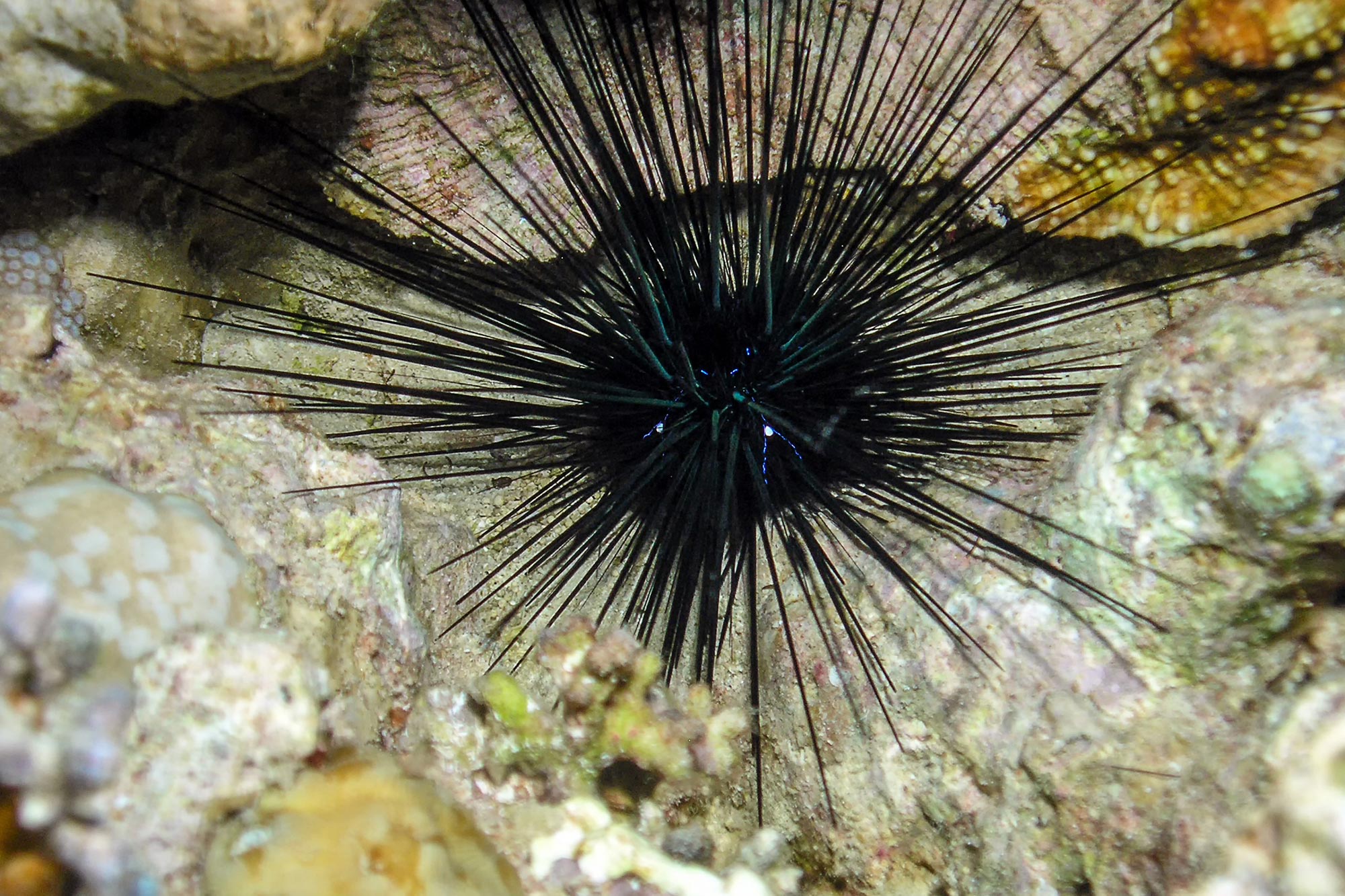Een eencellig organisme, scuticociliaat, is geïdentificeerd als de oorzaak van de massale sterfte in 2022 van langsdoornige zee-egels in het Caribisch gebied en de oostkust van Florida. Deze zee-egels zijn essentieel voor de gezondheid van koraalriffen en de ontdekking roept vragen op over de aanwezigheid van ciliaten, hun groeiomstandigheden en hun potentiële impact op andere soorten. Foto van de lange, stekelige zee-egel (Diadema antillarum).
De massale dood van de langsdoornige zee-egel – een verlies dat de gezondheid van koraalriffen van het Caribisch gebied tot de oostkust van Florida bedreigt – werd veroorzaakt door een eencellig organisme dat een ciliaat wordt genoemd.
De jacht op een moordenaar is in 2022 geëindigd die langs de langstekelige zee-egels in het Caribisch gebied en langs de oostkust van Florida heeft uitgeroeid. Een team van onderzoekers georganiseerd door Mia Breitbart, Distinguished University Professor aan het College of Marine Sciences van de University of South Florida, heeft een eencellig organisme, een ciliair genaamd, geïdentificeerd als de oorzaak van de massale dood van een zeedier dat van vitaal belang is voor de gezondheid van koraalriffen.
Hun bevindingen worden op 19 april gepubliceerd in het tijdschrift Nature
Ciliate culture viewed under the microscope. Credit: Mya Breitbart USF College of Marine Science
“We’re beyond thrilled to get to the bottom of the 2022 mystery and a bit stunned we did it so quickly,” said Breitbart, senior author on the Science Advances study and an expert in marine genomics. “We had a great team in place and the tools needed to do the ocean science equivalent of a forensic investigation.”
Ciliates are microscopic organisms covered in hair-like structures called cilia that help them move and eat. They are found almost anywhere there is water and most are not disease-causing agents. However, this specific species of ciliate – called a scuticociliate – has been implicated in die-offs of other marine species, such as sharks, in the past.

Photo compilation showing the same sea urchin before and after infection with the ciliate in the USF aquarium research facility. Credit: Makenzie Kerr USF College of Marine Science
Examining urchins collected from 23 sites in the Caribbean, the research team used a series of techniques to confirm the source of the die-off event.
After identifying the ciliate in every affected urchin specimen using genomic techniques, the team grew ciliates in the lab and performed infection experiments at the USF College of Marine Science. When the pathogen was introduced to otherwise healthy urchins in an aquarium tank, the urchins died within a few days – replicating what was taking place in the ocean and confirming the ciliate as the disease source.

DaSc-affected sea urchin, Aruba, August 2022. Credit: Ian Hewson Cornell University
“We’re excited to share this information with everyone, from reef managers to additional scientists so we can explore it further and try to stop its spread,” Breitbart said.

Mya Breitbart (USF) viewing the ciliate culture by microscopy. Credit: Makenzie Kerr USF College of Marine Science
The long-spined sea urchins inhabit shallow tropical waters and feed on algae that would otherwise destroy a reef. They began to lose their spines within days of contracting an unknown disease and died in droves starting in January 2022.
A similar die-off event took place in the early 1980s, which wiped out 98 percent of the long-spined sea urchin population. The culprit of that die-off remains a mystery.
Breitbart first got the call about the unfolding die-off at the end of March 2022. She immediately assembled a team consisting of Ian Hewson, lead author on the publication and a marine ecologist at Cornell University; Christina Kellogg, a microbiologist from the U.S. Geological Survey in St. Petersburg, Fla. who has worked extensively on coral reef diseases; and USF graduate student Isabella Ritchie.
“At the time, we didn’t know if this die-off was caused by pollution, stress, something else – we just didn’t know,” said Hewson, an expert in diseases that cause mass die-offs of sea stars, who flew from New York to the Caribbean Islands to observe the situation.
Even with the source of the mysterious die-off uncovered, questions still remain. For example:
- Is this ciliate new to the area, or was it there prior to the die-off?
- If it has been there, what environmental conditions favored its growth and why did it infect the urchins?
- Can it affect other species of urchins?
“Een theorie die we hebben is dat de ciliaat goed groeide onder de hoge productiviteitsomstandigheden die werden waargenomen in het Caribisch gebied toen het voor het eerst begon te vervagen, ” zei Kellogg. “We zijn ook nieuwsgierig naar het feit dat er enige overlap is in sommige van de geografische gebieden waar dit uitsterven plaatsvond en waar koraalriffen achteruitgaan als gevolg van de ziekte van steenachtig koraalweefsel.”
https://www.youtube.com/watch?v=-nPFN3yQMuk
Referentie: “Scuticocylaat-agent veroorzaakt massale sterfte van Diadema Antillarum in de Caribische Zee” door Ian Hewson, Isabella T Ritchie, James S Evans, Ashley Alterra, Donald Berenger, Irene Bowman, Marilyn Brandt, Kayla A. Budd en Rolio A. Camacho, Thomas O. Cornwell, Peter D. Kimani A. Kitson-Walters, Patricia Kramer, Judith C.Lang, Harilaos Lessios, Lauren Liddy, David Marancik, Stephen Nimrod, Joshua T. Patterson, Marit Pistor, Isabel C. Romero, Rita Sellares-Blasco, Moriah LB Sevier, William Sharp, Matthew Souza, Andrina Valdez-Trinidad, Maren van der Laan, Brian Villanova-Cuevas, Maria Villalpando, Sarah de Von Huene, Matthew Warham, Tom Weyers, Stacy M. Yanong, Soumira Zambrano, Alise Zimmerman, Mia Breitbart 19 april 2023 Hier beschikbaar. De wetenschap gaat vooruit.
DOI: 10.1126/sciadv.adg3200
Het onderzoek werd gefinancierd door de National Science Foundation, het Atkinson Rapid Response Center for Sustainable Futures, AGGRA, de National Oceanic and Atmospheric Administration, de National Fish and Wildlife Foundation, het Florida Keys Marine Preserve en de Florida Fish and Wildlife Commission.

“Bierliefhebber. Toegewijde popcultuurgeleerde. Koffieninja. Boze zombiefan. Organisator.”








More Stories
Een nieuw rapport zegt dat het gebruik van ras en etniciteit soms “schadelijk” is in medisch onderzoek
SpaceX lanceert 23 Starlink-satellieten vanuit Florida (video en foto’s)
NASA zegt dat de “Halloween-komeet” zijn vlucht langs de zon niet heeft overleefd